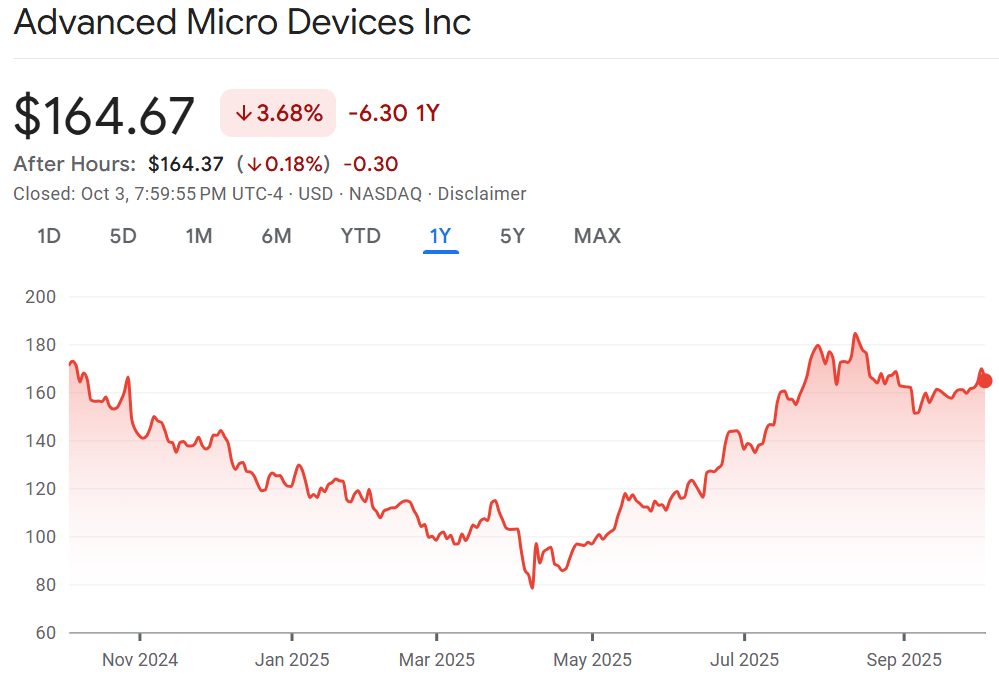- The Pragmatic Investor
- Posts
- 🚨 AMD’s 3% Dip Wasn’t Weakness, It Was Signal
🚨 AMD’s 3% Dip Wasn’t Weakness, It Was Signal

🌞Good Monday Morning, Folks!
This market is drunk.
AMD just dropped 3% on Friday — the same week it printed record revenue of $7.7B and nearly $900M in profit. You’d think strength under fire would earn a premium. Instead, the crowd sold first and asked questions never.
And that’s the part that drives me nuts. Investors don’t punish weakness anymore — they punish ambiguity. If the story isn’t perfectly clean, they’d rather hit the sell button than sit with complexity. That reflex costs them. Every. Single. Time.
So this week, I’m tearing into what really happened with AMD’s dip. Why a company proving resilience got treated like it broke. Why Intel fab rumors, China’s export toll, and Nvidia’s shadow are twisting the narrative. And why most people are missing the actual signal buried in the mess.
Because here’s the truth: the edge isn’t in chasing perfect stories — it’s in spotting resilience when it’s uncomfortable. And if you don’t learn to see that, you’ll keep selling strength and buying hype until your conviction account runs dry.
⚡ Quick Hits
🦫 Buffett’s Last Big Swing Before Abel Takes Over
Warren Buffett may be teeing up his final blockbuster deal as Berkshire Hathaway’s CEO before Greg Abel takes the reins. That’s not just a headline—it’s a succession signal. The next move could set the tone for Berkshire’s post-Buffett era, and if you dismiss it, you’ll miss how legacy capital shifts direction in real time.
🤖 Palantir Drops Hard—But That’s The Real Test
Palantir’s stock just fell sharply after earnings, sparking the usual “is the story broken?” panic. The contrarian view? This is exactly where long-term contracts and sticky government deals get tested. If you only watch the red on the screen, you’ll miss whether this is capitulation—or the moment when conviction pays.
🏡 Million-Dollar Homes Are Selling Faster Than Starter Homes
Forget affordability headlines: million-dollar homes are now the fastest-moving segment of the U.S. housing market. That’s not just housing data—it’s a wealth-gap alarm. The risk? If you’re positioned as though the middle-market sets the pace, you’ll be blindsided when luxury demand drives valuations and policy backlash instead.
TOGETHER WITH OUR PARTNER
Earn your PE certificate online. Build an MBA-style network.
The Wharton Online + Wall Street Prep Private Equity Certificate Program gives you the knowledge and tools top professionals use to analyze investment opportunities.
Learn from senior leaders at top firms like Carlyle, Blackstone, and KKR.
Get direct access to Wharton faculty in live office hours where concepts become clear, practical, and immediately applicable.
Study on your schedule with a flexible online format
Plus, join an active network of 5,000+ graduates from all over the world.
Enroll today and save $300 with code SAVE300.
Program begins February 9.
💡One Big Idea: AMD - The Drop That Wasn’t Weakness

AMD just posted record revenue of $7.7 billion. Net income? $872 million. And it did this while swallowing an $800 million inventory hit tied to China’s export mess.
That’s not weakness. That’s strength under pressure.
So why did the stock drop nearly 3% on Friday, October 3?
Because the market doesn’t price reality. It prices stories. And AMD’s story just got messy: Intel fab rumors evaporated, Washington keeps taxing margins through its China skim, and Nvidia continues to dominate the headlines.
Here’s the paradox: AMD is performing better than ever, yet it’s being punished harder than ever. That disconnect isn’t a reason to panic — it’s a reason to pay attention.
🔥 Why the Drop Happened
The first hit came from expectations. A report confirmed AMD won’t use Intel’s foundry for wafer production. For months, bulls whispered that Intel could ease AMD’s production constraints. That hope was baked into models. When the rumor collapsed, so did the multiple.
Second, the policy drag. The 15% China revenue skim is alive and real — Washington’s tollbooth to keep selling advanced chips into China. On paper, it preserves access. In practice, it shaves margins. Markets hate ambiguity. Investors will overpay for clarity, but they’ll discount anything that looks messy.
And third, the irony: fundamentals are solid. AMD grew 32% year-over-year. It printed positive net income even with an $800M charge. Execution is intact. Yet the stock slipped anyway. Because investors aren’t reacting to results — they’re reacting to the narrative collision between growth, policy, and competition.
🧠 What the Market Missed
This wasn’t just volatility. It was a test of conviction.
Most investors saw a 3% red candle and thought, “trend break.” That’s loss aversion speaking — the brain’s instinct to feel a small loss more painfully than a larger gain. But the truth is simple: price flinched, the business didn’t.
The market is recalibrating AMD around three fears:
Margins eroding from the China skim.
Capacity growth slowing without Intel.
Nvidia’s dominance squeezing AMD’s optionality.
But here’s the blind spot: resilience under constraint is itself a moat. Nvidia doesn’t have to navigate the same export tolls in the same way. Intel doesn’t carry the same investor expectations. AMD is uniquely positioned in the line of fire — and the fact it’s still delivering record revenue under these conditions isn’t a red flag. It’s a green one.
📊 The Psychology of Friday’s Move

A 3% dip doesn’t sound like much — until you feel it in your portfolio. That’s where most investors fail. They see red, they panic, and they forget context.
But let’s frame it clearly:
The volume on Friday was below panic levels. That means institutions weren’t dumping. Retail hands were flinching.
The fundamentals didn’t break. AMD’s record quarter still stands.
The narrative reset is temporary. Capacity rumors fade, China headlines cycle, Nvidia’s edge is known. What matters is the next margin print.
In other words: Friday’s move was a stress test. And the investors who fail that test are the ones who trade their conviction for comfort.
👀 What I’m Watching
Here’s how I separate noise from signal:
Margins: The next two quarters will reveal if gross margins bounce back post-write-down. If they do, the market’s panic looks misplaced.
AI accelerator cadence: The MI350 ramp later this year is AMD’s real lever — not the fab rumors. That’s the proof point.
Institutional flows: Watch whether funds treat this as a dip to add, or as a reason to trim. Their reaction matters more than retail chatter.
Price action near $160–$170: This is the conviction zone. If it holds, sentiment stabilizes. If it cracks, fear could anchor lower.
💡 Pragmatic Insight
Here’s the sticky line you need to remember:
“The market doesn’t price resilience in real time — it punishes ambiguity. And that’s when conviction pays.”
Friday’s dip wasn’t a thesis break. It was a thesis test. The business is still delivering. The pain came from investor psychology — the fear of uncertainty, the loss aversion triggered by red on the screen, the impatience for a “clean AI story” that AMD can’t give yet.
But clarity never comes when you want it. It comes when the crowd has already moved on. And that’s where edge lives: in holding through complexity while others sell comfort.
The question isn’t whether AMD dropped 3%. The question is: What does it mean that it dropped on a record quarter and still held its ground fundamentally?
That’s the real signal.
🧠 Final Thought
The market has a strange way of testing conviction. It doesn’t do it in obvious crashes or euphoric melt-ups. It does it in those quiet, irritating moves — like AMD dropping 3% on a record quarter. That’s where most investors fail, not because the story broke, but because their psychology did. Loss aversion whispers louder than fundamentals, and red candles feel heavier than balance sheets.
What I’ve learned is this: resilience never looks like resilience in the moment. It looks like noise, ambiguity, even punishment. Only in hindsight does the market label it strength. That’s why the edge isn’t in predicting perfection — it’s in preparing to sit with the discomfort until the signal is undeniable. If you can hold your frame when ambiguity reigns, you’re already ahead of most of the crowd.
🧠 What did you think of today's newsletter? |
Stay Sharp,
— AK

Disclaimer: The content on this blog is for educational and informational purposes only and is not intended as financial, investment, tax, or legal advice. Investing in the stock market involves risks, including the loss of principal. The views expressed here are solely those of the author and do not represent any company or organization. Readers should conduct their own research and due diligence before making any financial decisions. The author and publisher are not responsible for any losses or damages resulting from the use of this information.


Reply